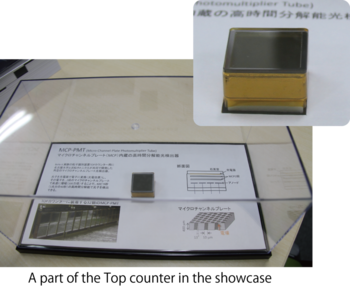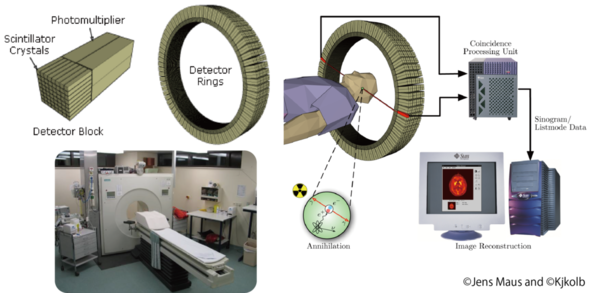Features
Features
Special Interview with Prof. Toru Iijima, World Research Unit for Heavy Flavor Particle Physics (established in 2014)
- ツイート
- 2016/11/18
- Graduate School of Science
- Prof. Toru Iijima
Since 2014, Nagoya University has supported researchers in forming promising international research hubs under the "Program for Promoting the Enhancement of Research Universities."
Prof. Toru Iijima, along with Prof. Junji Hisano and Associate Prof. Makoto Tomoto, Graduate School of Science at Nagoya University, established one such research hub, the "World Research Unit for Heavy Flavor Particle Physics," adopted as a cutting-edge international research unit in 2014. As evidenced by the vigorous progress of his work, in March 2016, Prof. Iijima was awarded the Shuji Orito Prize by the Heisei Foundation for Basic Science for his world-leading research in particle physics.
(Interview conducted by Ayako Umemura/NU Research)
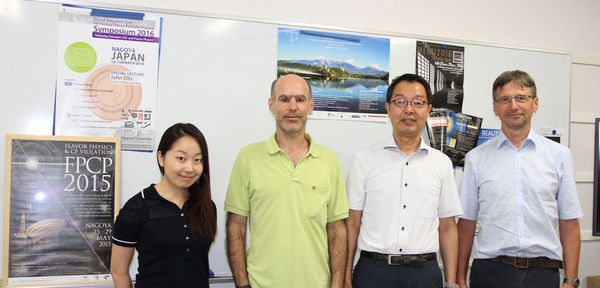 A picture at the interview. From the right, Prof. Peter Krizan, Prof. Toru Iijima, Prof. Abner Soffer, and Ms. Kaori Yonemura, a secretary of Prof. Toru Iijima.
A picture at the interview. From the right, Prof. Peter Krizan, Prof. Toru Iijima, Prof. Abner Soffer, and Ms. Kaori Yonemura, a secretary of Prof. Toru Iijima.
*Special thanks to Prof. Peter Krizan of the Jožef Stefan Institute in Slovenia and Prof. Abner Soffer of Tel Aviv University in Israel for participating in the interview with Prof. Iijima and sharing their frank opinions.
Physicists advance our appreciation of the Universe and its underlying particle physics.
On the basics: Standard Model of particle physics
NU Research:
Although fascinating, it is not easy to believe that grasp the magnificent scale of the Universe can be explained by tiny particles. To understand the basis of your research, we must understand what particle physics means in the first place.
Prof. Iijima:
We, the creatures, and the Universe are made up of materials. Materials comprise compounds, and the smallest pieces in compounds are molecules (10-9 m). Molecules are groups of atoms (10-10 m), which are the smallest pieces of matter. Each atom has substructure, nucleus (10-14 m), nucleon (10-15 m), and finally quarks (<10-18 m). All matter around us is made up of elementary particles, such as quarks and electrons.
 Materials constitution in images
Materials constitution in images
Prof. Iijima:
The Standard Model of particle physics, which has been explained so far, is shown below.
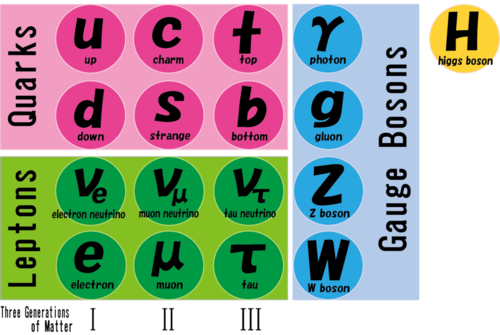 The Standard Model of particle physics
The Standard Model of particle physics
Prof. Iijima:
Matter particles can be categorized into two basic types, quarks and leptons. There are six particles in each of these two groups. The six quarks are paired in three generations; the "up quark" and "down quark" form the first generation because they are the lightest and most stable particles in the Universe, the "charm quark" and "strange quark" form the second generation, and the "top quark" and "bottom quark" form the third generation. The second- and third-generation particles are heavier and less stable than the first-generation particles, and quickly decay to the next most stable levels.
The six leptons are similarly arranged in three generations— the “electron,” “muon,” and “tau” —and they all have their individual counterparts: the “electron neutrino,” “muon neutrino,” and “tau neutrino,” respectively. Each electron, muon, and tau has an electric charge and a sizeable mass, whereas neutrinos are electrically neutral and have negligible mass.
The quarks and leptons are called fermions, which are the basic building blocks of all matter; there are also other blocks, which are called bosons or the force particles. In bosons, a strong interaction is mediated by the “gluon,” and the “W boson” and “Z boson” mediate a weak interaction. A “photon” is an electromagnetic force career. The “Higgs boson” is postulated to explain the origin of particle masses and was the last particle to be discovered, thereby completing the table of the Standard Model of particle physics. However, this does not mean everything has been proven yet.
The fermions, “top quark,” “bottom quark,” “charm quark,” and the “tau” lepton are collectively called as “heavy flavor particles,” which are the main research objectives in this research unit.
The 2008 Physics Nobel Prize
NU Research:
How were the particles that establish the Standard Model of particle physics discovered?
Prof. Iijima:
We needed both theoretical studies and experiments to find the particles. First, let me remind you that the 2008 Nobel Prize in Physics was awarded to Prof. Kobayashi and Prof. Maskawa, both graduated from Nagoya University, for their work on the breaking of symmetries in particles.
 Prof. Kobayashi (left) and Prof. Maskawa (right), Nobel laureates in Physics 2008
Prof. Kobayashi (left) and Prof. Maskawa (right), Nobel laureates in Physics 2008
Prof. Iijima:
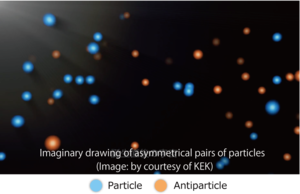 The Big Bang theory elucidates how our Universe began. Because of the extremely high energy density and massive temperatures and pressures resulting from the Big Bang, the Universe expanded and cooled very rapidly. Then, particle–antiparticle pairs were continuously created and annihilated in collisions; however, our current world only contains particles, and the antiparticles have disappeared.
The Big Bang theory elucidates how our Universe began. Because of the extremely high energy density and massive temperatures and pressures resulting from the Big Bang, the Universe expanded and cooled very rapidly. Then, particle–antiparticle pairs were continuously created and annihilated in collisions; however, our current world only contains particles, and the antiparticles have disappeared.
This shows that either the particle–antiparticle pairs were somehow asymmetrical or violated CP symmetry, whose origin was theoretically explained by Prof. Kobayashi and Prof. Maskawa in 1973. To determine the origin of the broken symmetry, they predicted the existence of at least three generations (or families) of quarks (i.e., six quarks) in nature even though only three of them, namely the “up quark,” “down quark,” and “strange quark,” were known at that time.
NU Research:
I know that your research group contributed to the discovery that won the Nobel Prize in Physics in 2008.
Prof. Iijima:
Our High Energy Physics Lab (commonly known as the N lab) has been experimentally exploring the laws of nature governing the particles, and therefore those governing the Universe, in collaboration with KEK, High Energy Accelerator Research Organization. Between 1998 and 2010, KEK operated KEKB, an asymmetric electron–positron collider with a 3-km circumference; KEKB created a world record in producing the highest instantaneous luminosity. As the beam collisions produced large numbers of B–antiB meson pairs in the collisions, the facility was also known as the B-factory. In fact, Belle, a B-factory experiment, as well as the BaBar conducted by the SLAC National Accelerator Laboratory in the US verified that the hypothesis on the origin of CP symmetry violation, as explained by Prof. Kobayashi and Prof. Maskawa was indeed correct.
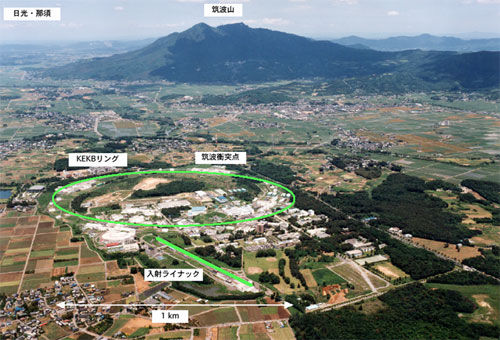 Panoramic view of KEKB
Panoramic view of KEKB
(Image: by courtesy of KEK)
NU Research:
Aside from the completion of the Standard Model of particle physics, using which you can prove “everything,” what actually attracts physicists like yourself?
Prof. Iijima:
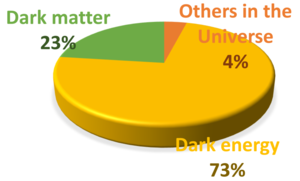 We physicists have not yet proved all of the behaviors exhibited by the particles and constituent materials that were present at the beginning of the Universe but have now disappeared. We can explain only 4% of the total energy in the Universe using the Standard Model; the remaining 23% and 73 % are dark matter and dark energy, respectively. By defining new laws of physics or exploring new particles, we believe that we can identify dark matter as well. We, particle physicists, believe that there must be a new theory (New Physics), which can explain mysteries in the Universe: how anti-matter disappeared and what the dark matter is.
We physicists have not yet proved all of the behaviors exhibited by the particles and constituent materials that were present at the beginning of the Universe but have now disappeared. We can explain only 4% of the total energy in the Universe using the Standard Model; the remaining 23% and 73 % are dark matter and dark energy, respectively. By defining new laws of physics or exploring new particles, we believe that we can identify dark matter as well. We, particle physicists, believe that there must be a new theory (New Physics), which can explain mysteries in the Universe: how anti-matter disappeared and what the dark matter is.
Establishment of the World Research Unit
NU Research:
We are observing that both theoretical study and experiments are being collaborated necessarily and, therefore, we have moved on to an exciting challenge for the exploration of New Physics.
Prof. Iijima:
To explore the new laws of physics as well as the violations of the symmetry between particles and antiparticles, I started the World Research Unit for Heavy Flavor Particle Physics with Prof. Junji Hisano and Associate Prof. Makoto Tomoto in 2014 under the Program for Promoting the Enhancement of Research Universities. I have worked on the B-factory experiments targeting heavier flavor particles, such as the “charm quark,” “bottom quark,” and “tau lepton.” For the “top quark,” a giant accelerator Large Hadron Collider (LHC) built at CERN in Europe was required. Associate Prof. Tomoto has provided expert insight into the “top quark” and “Higgs boson” work that is being conducted at LHC-ATLAS in CERN. By cooperating with Prof. Hisano, a phenomenology theorist, we managed to strengthen the exploration of New Physics by exceeding standard physics.
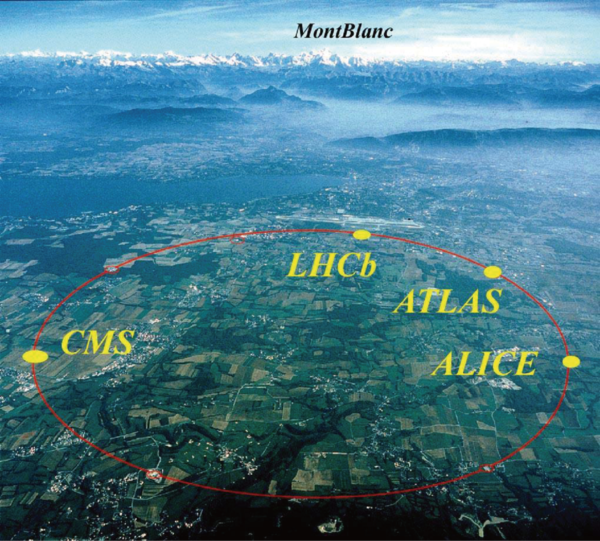 Panoramic View of LHC-ATLAS and others in CERN
Panoramic View of LHC-ATLAS and others in CERN
(Image: by courtesy of ATLAS JAPAN)
Prof. Iijima:
In addition, since 2000, we have closely collaborated with an international visiting researcher Prof. Peter Krizan of the Jožef Stefan Institute in Slovenia mainly for the B-factory experiments. Moreover, many international researchers have been invited to work with us. Prof. Abner Soffer of Tel Aviv University in Israel is also one of those working with us on the B-factory experiments.
NU Research:
It absolutely is the World Research Unit! How do the members manage to make progress with one another?
Prof. Iijima:
Prof. Peter Krizan and I have collaborated for a long time to conduct physics analyses using the Belle data and also to develop new particle detectors for the next generation experiment. The World Research Unit boosts this collaboration, and it also widen our research with new collaborators such as Prof. Abner Soffer. Also, the World Research Unit provides a framework to establish international collaboration at a campus based rather than a big laboratory. This will provide opportunities to meet and discuss directly with world-leading international researchers. We have been planning and conducting workshops and symposia at least twice a year.
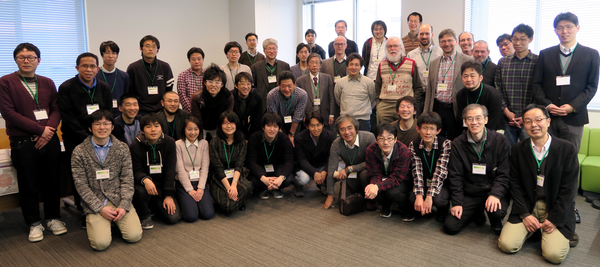 International research members at a symposium
International research members at a symposium
(Image: by courtesy of Prof. Iijima)
Prof. Krizan:
In workshops, researchers engage in an interactive discussion on what we are interested in and what results we have produced. Eventually, we discuss how to produce a detailed result and what its impact will be. We have made good progress by doing so. Our network is also expanding because of these workshops.
Prof. Iijima:
Students are also involved in these interactive workshops. They make poster presentations, which provide an important opportunity for them to develop their researching skills and the other related activities.
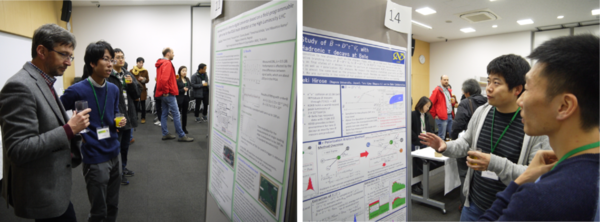 A scene of workshop
A scene of workshop
(Image: by courtesy of Prof. Iijima)
Prof. Soffer:
Apart from participating in these workshops, I have stayed to work at Prof. Iijima’s lab for two months this year. I often visit here, actually whenever I am here, I make some progress by engaging in fruitful discussions with the research staff and students.
Prof. Iijima:
That is true. As for the students, we encourage the exchange of students between our laboratories. It is important for them to broaden their international perspective, by being involved in world-leading research teams.
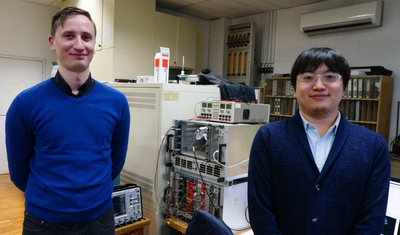 Student exchange is effectively planned between the laboratories
Student exchange is effectively planned between the laboratories
(Image: by courtesy of Prof. Iijima)
Powerful approaches through collaboration
NU Research:
Establishment of the World Research Unit has facilitated collaborations among world’s leading experimentalists and theorists. What other areas would you like to see researched and progressed?
Prof. Iijima:
We have two powerful approaches for exploring new particles.
The first approach is called “the energy frontier,” which can directly search for new particles in extremely high-energy proton–proton collisions in the LHC experiment.
When the “Higgs boson” was experimentally observed using the LHC, the collision energy was approximately 7–8 TeV. Since then, this value has been upgraded continuously, and after 2015, it will possibly have reached 13–14 TeV. By almost doubling the collision energy, we expect that new particles, which could not be observed before, will be discovered in the future.
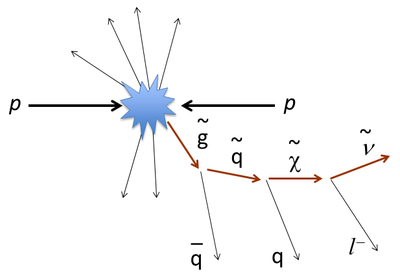 Conceptual image of "the energy frontier." Proton-proton collision produces many particles.
Conceptual image of "the energy frontier." Proton-proton collision produces many particles.
(Image: by courtesy of Prof. Iijima)
Prof. Iijima:
The other approach is called “the luminosity frontier.” We have addressed several particles, e.g., the “bottom quark,” using this approach. In particular, this quark is unstable and decays into two different particles; for example, the “strange quark” and “photon.” It is interesting thing to note that at the intermediate state of the decay, unknown particles can be produced if it exists for a very short time because of the Uncertainty principle.
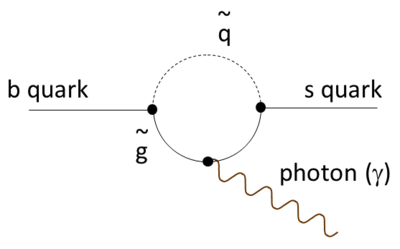 Conceptual image of “the luminosity frontier.” Unknown particles are expected to appear at the intermediate state of the decay.
Conceptual image of “the luminosity frontier.” Unknown particles are expected to appear at the intermediate state of the decay.
(Image: by courtesy of Prof. Iijima)
Prof. Iijima:
In 2010, KEK started constructing the SuperKEKB accelerator, which is an upgraded version of the KEKB accelerator and can perform collisions with 40 times greater energy. In the SuperKEKB accelerator, the second experiment, Belle II, is able to accumulate 50 times more data than our previous experiment, Belle, and can record large numbers of particle processes. This will make pursuing the violations of the symmetry between particles and antiparticles more precise; therefore, we believe that new laws of physics will be defined.
NU Research:
The powerful accelerators that have been prepared for the research are very exciting!
Prof. Iijima:
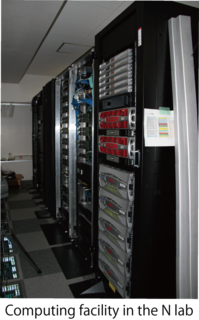 In addition, we have developed two original productions as a research hub. The first is an intensification of our computing facility for data analyses so that it can operate with 50 times more accumulated data in Belle II. The other is a detector called TOP counter, using which we intend to improve the experiment sensitivity to new particles.
In addition, we have developed two original productions as a research hub. The first is an intensification of our computing facility for data analyses so that it can operate with 50 times more accumulated data in Belle II. The other is a detector called TOP counter, using which we intend to improve the experiment sensitivity to new particles.
Prof. Iijima:
The TOP counter is partially exhibited in the Photo. When high-speed charged particles pass through the quartz bar, Cherenkov radiation is produced, and propagates in the quartz bar with total internal reflection. Consequently, we have obtained the time resolution to measure the Time-Of-Propagation (TOP) of each Cherenkov photon that is less than 50 picoseconds. This enables us to measure the velocity of the charged particles, produced with almost close to the light velocity by beam collisions, with an error of less than 0.2 %.
NU Research:
With such powerful computing technology and detectors developed by your research team, it seems possible that unknown particles and new laws of physics will be determined soon.
Prof. Iijima:
There is no doubt that we have formed an excellent international team, which can discover these unknown entities. In fact, Nagoya University has a strong history in this research field. Moreover, we have taken advantage of working with the powerful performances of the LHC and SuperKEKB.
I believe that the results obtained will influence society. I also think that technology developed for such fundamental research will nurture innovation; as you know, radiotherapy of positron emission tomography systems was introduced into our society as an application derived from particle physics.
Prof. Iijima:
In fact, Prof. Peter Krizan and I are developing a new type of PET (Positron Emission Tomography) system, by applying the technique developed for the TOP counter.
By the fiscal year 2019, which will mark the end of the project, we will have done our utmost to produce fruitful results.
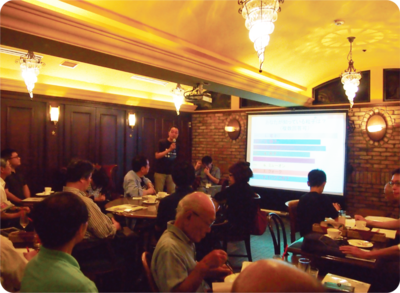 Prof. Iijima at Science Talk with general public (on Sept. 26th 2016)
Prof. Iijima at Science Talk with general public (on Sept. 26th 2016)
NU Research:
Basic research is essential to develop new systems.
Thank you very much for the description of your research in detail. I am now more familiar with particle physics and looking forward to your achievements that would come in a short while.
Links
- Program for Promoting the Enhancement of Research Universities at Nagoya University HP http://aip-nagoya.com/ru/english/index.html
- World Research Unit for Heavy Flavor Particle Physics HP http://wru.hepl.phys.nagoya-u.ac.jp/
- N lab (High Energy Physics) HP http://www.hepl.phys.nagoya-u.ac.jp/
- Department of Physics, Graduate School of Science HP https://www.phys.nagoya-u.ac.jp/en/index.html
NU Research
(English)


